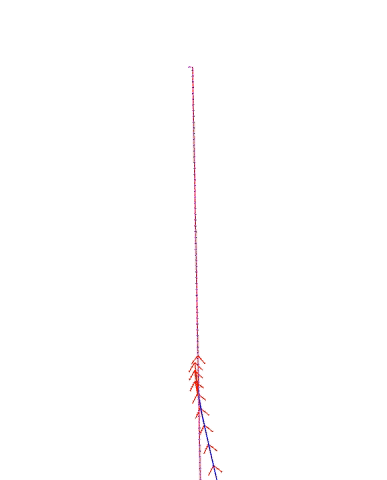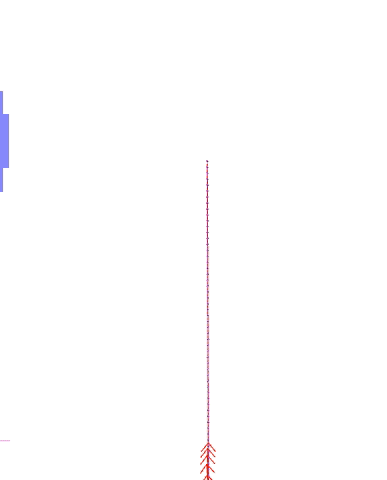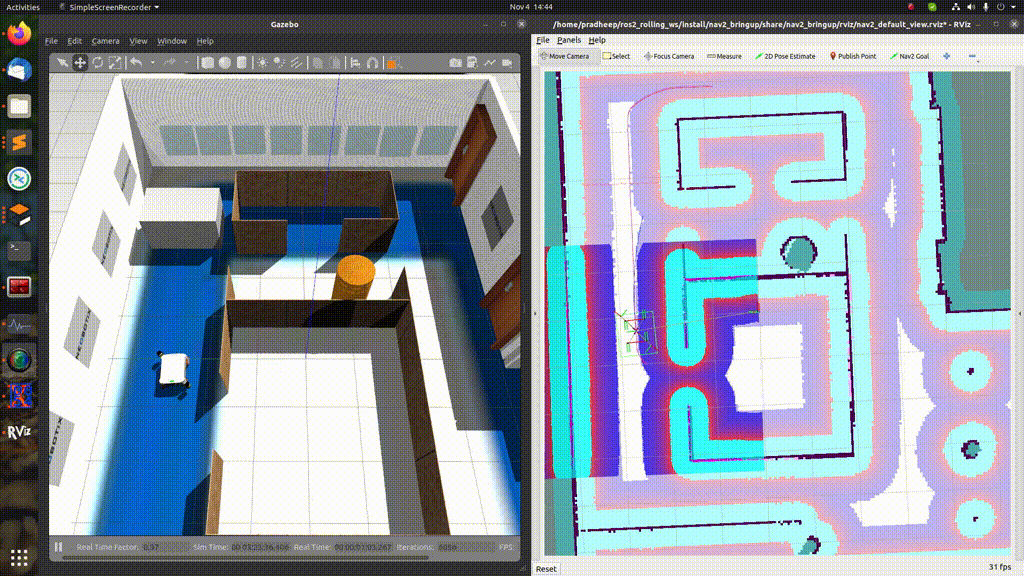Galactic to Humble
Moving from ROS 2 Galactic to Humble, a number of stability improvements were added that we will not specifically address here.
Major improvements to Smac Planners
The Smac Planner was significantly improved, of both the 2D and Hybrid-A* implementations, making the paths better, faster, and of higher quality.
Collision checker rejects collisions faster and queries the costmap for coordinates less often
Zero-copy collision checking object
precompute collision checking footprint orientations so no need for trig at runtime
Only checking full SE2 footprint when the robot is in the possibly inscribed zones
Computing the possibly inscribed zones, or the cost over which some part of the footprint may be in collision with a boundary to check the full footprint. Else, check center cost since promised to not be in a potential collision state
Renaming Hybrid-A* planner to SmacPlannerHybrid
Precomputing the Reedshepp and Dubin paths offline so at runtime its just a lookup table
Replacing the wavefront heuristic with a new, and novel, heuristic dubbed the obstacle heuristic. This computes a Dijkstra’s path using Differential A* search taking into account the 8 connected space, as well as weights for the cost at the positions to guide the heuristic into the center of aisle ways. It also downsamples the costmap such that it can reduce the number of expansions by 75% and have a very small error introduced into the heuristic by being off by at most a partial fraction of a single cell distance
Improvements to the analytic expansion algorithm to remove the possibility of loops at the end of paths, whenever possible to remove
Improving analytic expansions to provide maximum path length to prevent skirting close to obstacles
2D A* travel cost and heuristic improvements to speed up planning times and also increase the path quality significantly
Replaced smoother with a bespoke gradient descent implementation
Abstract out common utilities of planners into a utils file
tuned cost functions
precomputed obstacle heuristic using dynamic programming to expand only the minimum number of nodes
A caching heuristic setting to enable 25hz planning rates using cached obstacle heuristic values when the goal remains the same
Leveraging the symmetry in the dubin and reeds-sheep space to reduce cache size by 50% to increase the window size available for heuristic lookup.
Precompute primitives at all orientation bins
SmacPlanner2D parameters are now all reconfigurable
Both Hybrid-A* and State Lattice planners are now fully admissible
Hybrid-A* and State Lattice have had their parameterization for path smoothing re-added.
The smoother now enables kinematically feasible boundary conditions.
State Lattice supports turning in place primitive types
Retrospective penalty added to speed up the planner, making it prioritize later search branches before earlier ones, which have negligible chance to improve path in vast majority of situations
- The tl;dr of these improvements is:
Plans are 2-3x as fast as they were before, well under 200ms for nearly all situations, making it as fast as NavFn and Global Planner (but now kinematically feasible). Typical planning times are sub-100ms without even making use of the caching or downsampling features.
Paths are of significantly higher quality via improved smoothers and a novel heuristic that steers the robot towards the center of aisleways implicitly. This makes smoother paths that are also further from obstacles whenever possible.
Using caching or downsampler parameterizations, can easily achieve path planning with sub-50ms in nearly any sized space.
Smoother is now able to do more refinements and can create kinematically feasible boundary conditions, even while reversing.
Additional improvements were made to include a analytic_expansion_max_length parameter such that analytic expansions are limited in their potential length. If the length is too far, reject this expansion. This prevents unsafe shortcutting of paths into higher cost areas far out from the goal itself, let search to the work of getting close before the analytic expansion brings it home. This should never be smaller than 4-5x the minimum turning radius being used, or planning times will begin to spike.
Further, the traversal cost and heuristic cost computations were updated requiring retuning of your penalty functions if you have a previously existing configuration. Defaults of the algorithm were also retuned appropriately to the change for similar our of the box behavior as before (to use as a reference).
Simple (Python) Commander
This PR 2411 introduces a new package to Nav2, called the nav2_simple_commander. It is a set of functions in an object, BasicNavigator, which can be used to build Nav2-powered autonomy tasks in Python3 without concerning yourself with the Nav2, ROS 2, or Action server details. It contains a simple API taking common types (primarily PoseStamped) and handles all of the implementation details behind the hood. For example, this is a simple navigation task using this API:
def main():
rclpy.init()
navigator = BasicNavigator()
# Set our demo's initial pose
initial_pose = PoseStamped()
... populate pose ...
navigator.setInitialPose(initial_pose)
# Wait for navigation to fully activate
navigator.waitUntilNav2Active()
# Go to our demos first goal pose
goal_pose = PoseStamped()
... populate pose ...
navigator.goToPose(goal_pose)
while not navigator.isTaskComplete():
feedback = navigator.getFeedback()
... do something with feedback ...
# Basic navigation timeout
if Duration.from_msg(feedback.navigation_time) > Duration(seconds=600.0):
navigator.cancelNav()
result = navigator.getResult()
if result == TaskResult.SUCCEEDED:
print('Goal succeeded!')
elif result == TaskResult.CANCELED:
print('Goal was canceled!')
elif result == TaskResult.FAILED:
print('Goal failed!')
The full API can be found in the README of the package. A number of well commented examples and demos can also be found in the package’s source code at the link prior.
Reduce Nodes and Executors
In order for nav2 to make the best use of ROS 2, we need minimize the number of nodes and executors in nav2, which can improve performance.
This functionality has been discussed in the ticket #816, and carried out in
Remove
client_node_inclass WaypointFollower: PR2441Remove
rclcpp_node_inclass MapSaver: PR2454Remove
bond_client_node_inclass LifecycleManager: PR2456Remove
node_inclass LifecycleManagerClient: PR2469Remove
rclcpp_node_inclass ControllerServer: PR2459, PR2479Remove
rclcpp_node_inclass AmclNode: PR2483Remove
rclcpp_node_andclinet_node_inclass Costmap2DROS: PR2489Remove
rclcpp_node_inclass LifecycleNode: PR2993
- some APIs are changed in these PRs:
Extending the BtServiceNode to process Service-Results
This PR 2481 and PR 2992 address the ticket and this ticket and adds a virtual on_completion() function to the BtServiceNode class (can be found here).
Similar to the already existing virtual on_wait_for_result() function, it can be overwritten in the child class to react to a respective event with some user-defined operation.
The added on_completion() function will be called after the service interaction of the BtServiceNode has been successfully completed.
/**
* @brief Function to perform some user-defined operation upon successful
* completion of the service. Could put a value on the blackboard.
* @param response can be used to get the result of the service call in the BT Node.
* @return BT::NodeStatus Returns SUCCESS by default, user may override to return another value
*/
virtual BT::NodeStatus on_completion(std::shared_ptr<typename ServiceT::Response>/*response*/)
{
return BT::NodeStatus::SUCCESS;
}
The returned BT::NodeStatus will set the current status of the BT-Node. Since the function has access to the results of the service, the returned node-status can depend on those service results, for example.
The normal behavior of the BtServiceNode is not affected by introducing the on_completion() function, since the the default implementation still simply returns BT::NodeStatus::SUCCESS, if the service interaction completed successfully.
Including new Rotation Shim Controller Plugin
This PR 2718 introduces the new nav2_rotation_shim_controller. This controller will check the rough heading difference with respect to the robot and a newly received path. If within a threshold, it will pass the request onto the primary controller to execute. If it is outside of the threshold, this controller will rotate the robot towards that path heading. Once it is within the tolerance, it will then pass off control-execution from this rotation shim controller onto the primary controller plugin. At this point, the robot is still going to be rotating, allowing the current plugin to take control for a smooth hand off into path tracking.
The Rotation Shim Controller is suitable for:
Robots that can rotate in place, such as differential and omnidirectional robots.
Preference to rotate in place rather than ‘spiral out’ when starting to track a new path that is at a significantly different heading than the robot’s current heading.
Using planners that are non-kinematically feasible, such as NavFn, Theta*, or Smac 2D (Feasible planners such as Smac Hybrid-A* and State Lattice will start search from the robot’s actual starting heading, requiring no rotation).
Spawning the robot in Gazebo
This PR 2473 deletes the pkg nav2_gazebo_spawner inside nav2_bringup directory. Instead of nav2_gazebo_spawner the Node spawn_entity.py of gazebo_ros is recommended to spawn the robot in gazebo.
Note that
gazebo should be started with both
libgazebo_ros_init.soandlibgazebo_ros_factory.soto work correctly.spawn_entity node could not remap /tf and /tf_static to tf and tf_static in the launch file yet, used only for multi-robot situations. This problem was overcame by adding remapping argument
<remapping>/tf:=tf</remapping><remapping>/tf_static:=tf_static</remapping>under ros2 tag in each plugin which publishes transforms in the SDF file. It is essential to differentiate the tf’s of the different robot.
Recovery Behavior Timeout
Recoveries in Nav2, spin and backup, now have time_allowance ports in their BT nodes and request fields in their actions to specify a timeout. This helps ensure that the robot can exit a backup or spin primitive behavior in case it gets stuck or otherwise is unable to backup the full distance over a reasonable block of time.
New parameter use_final_approach_orientation for the 3 2D planners
Pull request 2488 adds a new parameter use_final_approach_orientation to the 3 2D planners (Theta*, SmacPlanner2D and NavFn), false by default. If true, the last pose of the path generated by the planner will have its orientation set to the approach orientation, i.e. the orientation of the vector connecting the last two points of the path. It allows sending the robot to a position (x,y) instead of a pose (x,y,theta) by effectively ignoring the goal orientation.
For example, below, for the same goal with an orientaton pointed left of the screen, use_final_approach_orientation=false (left) and use_final_approach_orientation=true (right)


SmacPlanner2D and Theta*: fix goal orientation being ignored
This pull request 2488 fixes the issue of the goal pose orientation being ignored (the end path pose orientation was always set to 0).
Change and fix behavior of dynamic parameter change detection
This and this PR modify the method used to catch the changes of dynamic parameters. The motivation was to fix the issue that void on_parameter_event_callback(const rcl_interfaces::msg::ParameterEvent::SharedPtr event) was called for every parameter change of every node leading to unwanted parameter changes if 2 different nodes had the same parameter name.
Dynamic Parameters
Newly added dynamic parameters to:
This PR 2592 makes most of the Costmap2DROS parameters dynamic
This PR 2607 makes most of the Regulated Pure Pursuit parameters dynamic
This PR 2665 makes most of the Theta * Planner parameters dynamic
This PR 2704 makes Waypoint Follower, Planner Server, and Controller Server’s params reconfigurable
BT Action Nodes Exception Changes
When BT action nodes throw exceptions due to networking or action server failures, they now return a status code of FAILURE to fail that particular action in the behavior tree to react to. This is in contrast to prior where the exceptions thrown from networking were sent to the root tree which would count as a task-level failure that the tree could not react to.
Removed Kinematic Limiting in RPP
The parameters max_linear_accel and max_linear_decel were removed along with the kinematic limiting in the controller causing instabilities. Instead, use a velocity smoother available in the ROS ecosystem if you would like similar behavior.
Added Smoother Task Server
A new task server was added which loads smoother plugins and executes them to improve quality of an existing planned path. Smoothing action can be called from a behavior tree using SmoothPath action node. PR 2569 implements and PR 2875 adds in the first of the plugins using it with a simple smoother. Other smoothers are in development and will be added in the future.
Removed Use Approach Velocity Scaling Param in RPP
The parameter use_approach_linear_velocity_scaling is removed in favor of always on to help in smooth transitions to the goal. This PR 2701 implements.
Refactored AMCL motion models as plugins
This PR 2642 creates plugins for the different motion models currently used in AMCL. This functionality enables users to use any custom motion model by creating it as a plugin and changing the robot_model_type parameter to the name of the plugin in nav2_params.yaml file. This helps to use custom motion models without the need to modify the AMCL source code.
Replanning Only if Path is Invalid
This PR 2591 creates two new condition BT node to facilitate replanning only if path becomes invalid rather than constantly replanning. These new nodes were integrated into the default BT.
Fix CostmapLayer clearArea invert param logic
This PR 2772 fixes the invert paramlogic of the CostmapLayer clearArea function. Hence correcting the behavior of the clearAroundRobot and clearExceptRegion services and their corresponding BT actions.
Dynamic Composition
This PR 2750 provides a optional bringup based on ROS2 dynamic composition for users. It can be used to compose all Nav2 nodes in a single process instead of launching these nodes separately, which is useful for embedded systems users that need to make optimizations due to harsh resource constraints. it’s used by default, but can be disabled by using the launch argument use_composition:=False.
Some experiments to show performance improvement of dynamic composition, and the cpu and memory are captured by psutil :
CPU: Intel(R) i7-8700 (6Cores 12Threads), Memory: 32GB
cpu(%)
memory(%)
normal multiple processes
44
0.76
dynamic composition (use
component_container_isolated)38
0.23
The way of dynamic composition consumes lower memory(saves ~70%), and lower cpu (saves ~13%) than normal multiple processes.
BT Cancel Node
This PR 2787 caters the users with an abstract node to develop cancel behaviors for different servers present in the Nav2 stack such as the controller_server, recovery_server and so on. As a start, this PR also provides the CancelControl behavior to cancel the goal given to the controller_server. As an addition to the CancelControl This PR 2856 provides the users with the option to cancel the recoveries such as the backup, spin and wait.
BT PathLongerOnApproach Node
In the PR, a new Decorator BT node known as PathLongerOnApproach has been added to provide with the functionality to check and potentially handle longer path generated due to an obstacle in the given goal proximity. To demonstrate this functionality, a new BT navigate_to_pose_w_replanning_goal_patience_and_recovery.xml would serve both as an example and ready-to-use BT for a specific application that wishes to optimize their process cycle time. Demo of the developed BT can be seen below, where the robot pauses when close to a goal to see if the dynamic obstacle moves out of the way. Else, it executes the replan:
Obstacle does not clear at all, with obstacle_clearance_time to be 3 seconds:

Obstacle clears and you can see the robot pass through the (could have been ideally the) same path:

BT TruncatePathLocal Node
In the PR 2753, a new Action BT node named TruncatePathLocal has been added to extract a bounded-length path section near robot to be used e.g. for collision checking or computationally expensive smoothers
Constrained Smoother
In the PR 2753, a new Smoother named nav2_constrained_smoother::ConstrainedSmoother has been added to optimize various path criteria such as smoothness or distance from obstacles, maintaining minimum turning radius
Replanning at a Constant Rate and if the Path is Invalid
This PR 2804 introduces a new behavior tree that navigates to pose with consistent replanning and if the path becomes invalid. To facilitate the new behavior tree a new condition node PathExpiringTimer was introduced to trigger replanning at a consistent rate.
Euclidean Distance 2D
This PR 2865 changes Euclidean distance calculation throughout nav2 to project on to the XY plane (i.e. discard any information related to components in Z). This may potentially subtly change the way certain BT nodes, BT Navigators, controller servers, planner servers, and RPP behave if using custom plugins outside the Nav2 ecosystem.
Recovery To Behavior
This PR 2867 renames the nav2_recoveries to nav2_behaviors.
In navigation_launch.py recoveries_server -> behavior_server and nav2_recoveries -> nav2_behaviors. In nav2_params.yaml recovery_plugins -> behavior_plugins and nav2_recoveries -> nav2_behaviors.
Respawn Support in Launch and Lifecycle Manager
PR 2752 enables respawn support in Nav2. In the launch files, you may set use_respawn to true to enable respawning of servers that crash. This is only available in non-composed systems, since in composed systems, all of the nodes are under a single process and a crash anywhere will bring everything down (including the lifecycle manager itself). Even if the container was set to respawn, it would only respawn the empty container, not with all of the components loaded into it.
That PR also enables the lifecycle manager to check if a system goes down due to a crash. If so, it allows the manager to check if the server comes back online within a given timeout period. If it does, it will automatically retransition the system back up to active to continue on its task automatically.
Goal Checker API Changed
PR 2965 adds an extra argument in the initialize function of the nav2_core::GoalChecker class. The extra argument is a costmap_ros pointer. This is used to check if the goal is in collision, so that we can avoid moving towards the goal and replanning can be initiates using some BT plugin.